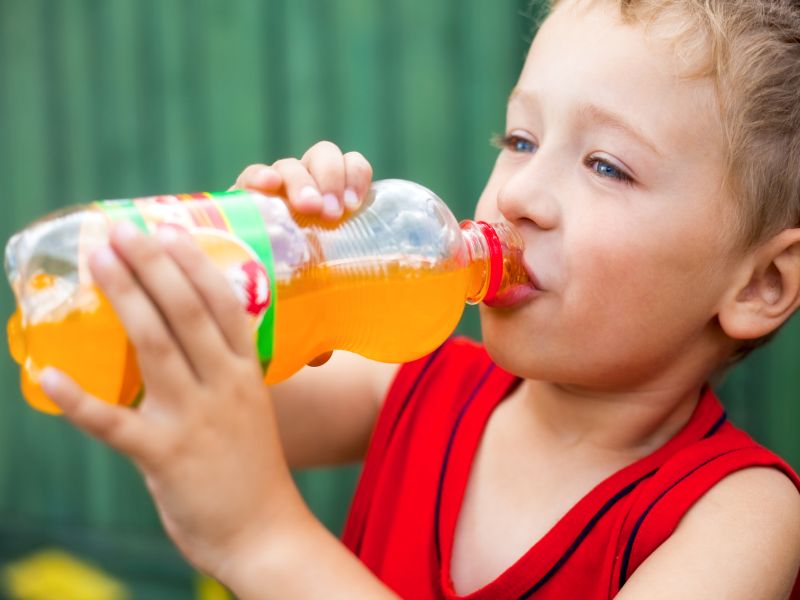
American youngsters are drinking far fewer sodas and other sugar-sweetened drinks and getting far fewer calories from them than they used to, a new report finds.
But kids from more-affluent homes are benefiting more from these trends than those from poorer families, the researchers said.
For example, the percentage of kids from more-affluent homes who drank at least one sweetened beverage each day fell from about 82% in 2003 to 68% in 2014, federal data shows.
But for poorer kids - those whose families were enrolled in the Supplemental Nutrition Assistance Program (SNAP) - daily sweetened beverage consumption fell from 84% in 2003 to 75.6% in 2014, a much smaller decline.
SNAP is the U.S. federal program that provides food assistance to more than 40 million low-income Americans each month, half of whom are children.
Overall, "our results confirm that efforts to decrease sugar-sweetened beverage consumption over the past decade have been successful," said study senior author Sara Bleich. She's with the department of health policy and management at the Harvard T.H. Chan School of Public Health, in Boston.
Her team reported their findings Nov. 21 in the American Journal of Preventive Medicine.
Despite some improvements, Bleich's team stressed that kids are still consuming too many high-calorie, sugar-sweetened beverages.
Overall, 61% of all children and teens consume some form of sugary drink on a typical day, the study authors said, and that number rises even higher - to about 76% - for kids from families enrolled in SNAP.
And while kids' intake of sodas and fruit drinks have charted steady declines, trends with other beverages could undercut that progress.
For example, consumption of sugary sports or energy drinks have more than tripled among kids enrolled in SNAP. In 2003, just 2.6% of these youngsters consumed this type of drink each day, but that number rose to 8.4% by 2014, the report found. Similar trends were found with flavored milk.
"These trends could reduce or eliminate the past decades' achievements limiting sugar-sweetened beverage consumption," Bleich said in a journal news release.
The report was based on 2003 to 2014 U.S. National Health and Nutrition Examination Survey data on more than 15,600 children and teens.
Two nutritionists unconnected to the new study said the data was encouraging, but far more has to be done.
"I work with children and adolescents who have obesity, type 2 diabetes and pre-diabetes. Many of these children also have elevated cholesterol and triglyceride levels," noted registered dietitian Audrey Koltun.
"The first nutrition goal that is usually set is to decrease or eliminate all sugar-sweetened beverages from their diets. These beverages add hundreds of empty calories and excess sugar contributing to weight gain," said Koltun, who works in the division of pediatric endocrinology at Cohen Children's Medical Center in New Hyde Park, N.Y.
Koltun said that 100% fruit juice is just as big a calorie-booster for kids as sodas. "When consumed in excess, it also has too much sugar and is not usually considered a healthy beverage," she said. "It fits into the same category as sugar-sweetened beverages except it is a naturally sugar-sweetened beverage."
In her opinion, "the healthy beverages that I recommend are water, seltzer or white milk (not flavored milks)."
Dr. Michael Grosso is chief of pediatrics at Northwell Health's Huntington Hospital in Huntington, N.Y. He believes that sugary beverages harm kids' health in three ways.
First, they help boost dental cavities; second, sweet drinks can replace healthier foods in kids' diets; and third, "an excess of simple carbohydrates - otherwise known as sugar - causes our bodies to make more insulin, promoting weight gain and all of its many consequences, from type 2 diabetes to high blood pressure and heart disease," Grosso said.
He had some blunt advice for parents.
"When to introduce full-strength fruit juices? How about never! Sodas? Ditto," Grosso said. Instead, "eat real foods - like fruits, grains and vegetables - and not too much [food]. And remember that the best way to hydrate after exercise is to drink water."
As for kids enrolled in SNAP, Bleich noted that the program's primary goals are to reduce hunger and food insecurity, but its secondary goals are to improve diet quality and prevent obesity.
"Current policy debates are considering whether the diet quality of SNAP participants can be improved by restricting which items can be purchased with SNAP benefits. Our analysis is important for these discussions," she said.
Sources: Audrey Koltun, R.D., CDE, CDN, registered dietitian/nutritionist, division of pediatric endocrinology, Cohen Children's Medical Center, New Hyde Park, N.Y.; Michael Grosso, M.D., chief medical officer and chair, pediatrics, Northwell Health's Huntington Hospital, Huntington, N.Y.; American Journal of Preventive Medicine, news release, Nov. 21, 2019.







0 Comments